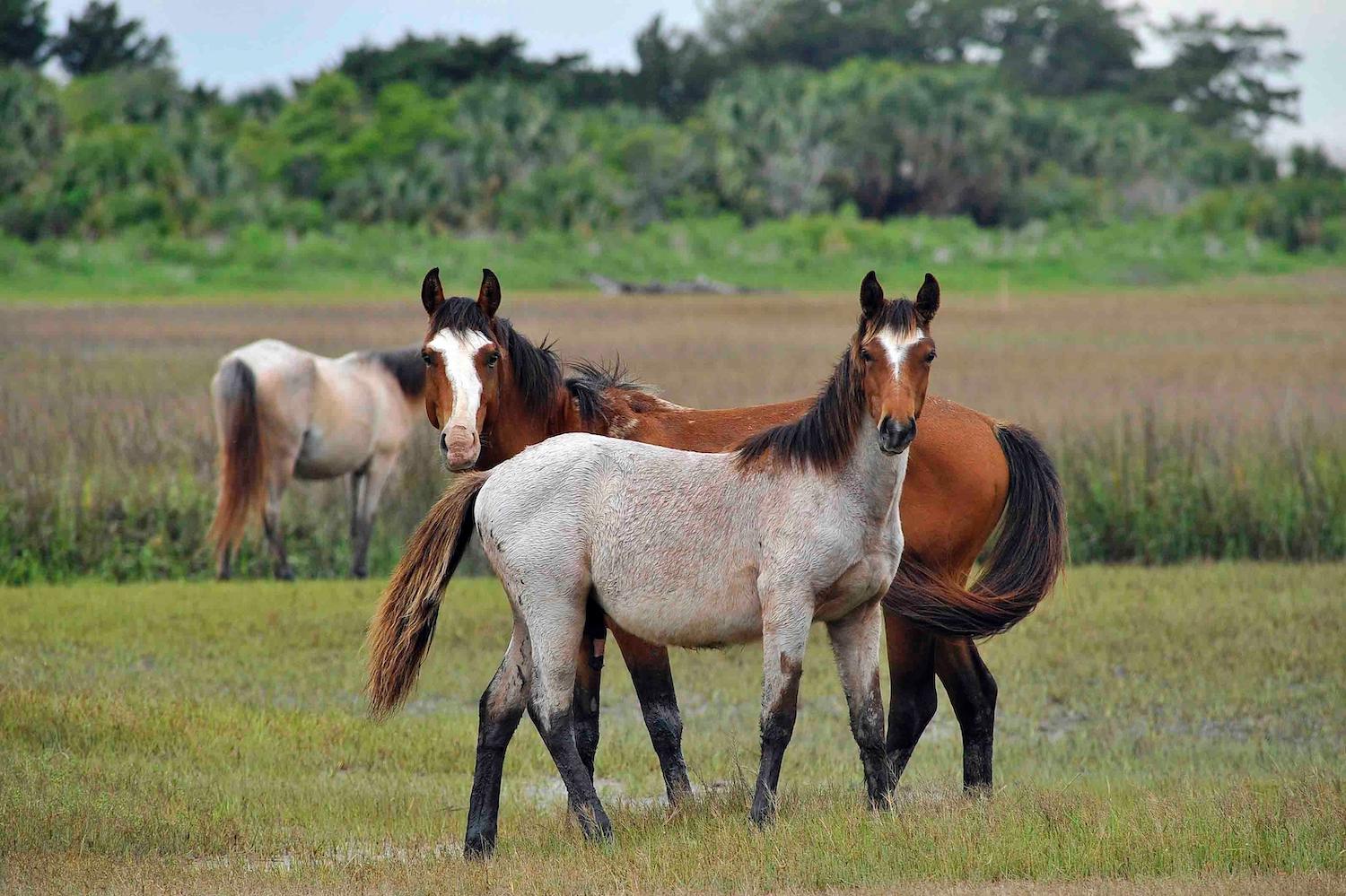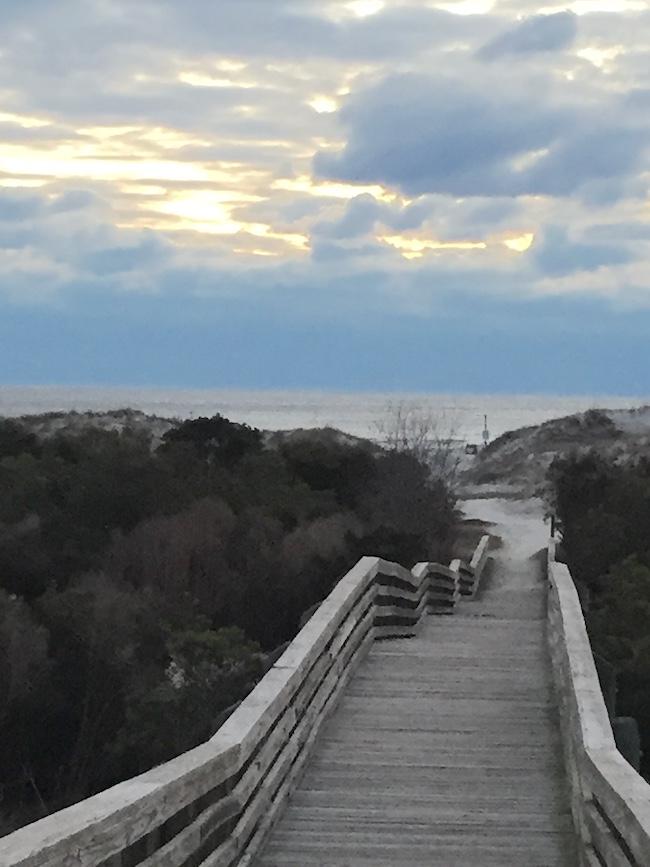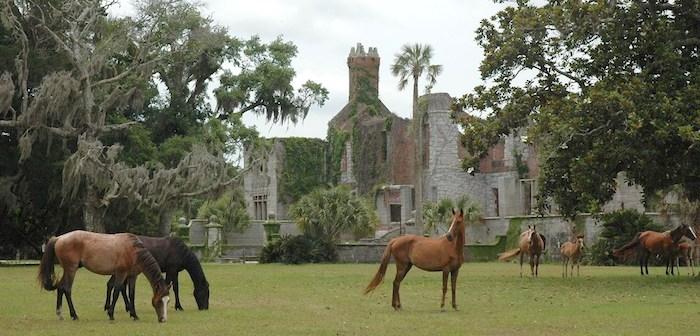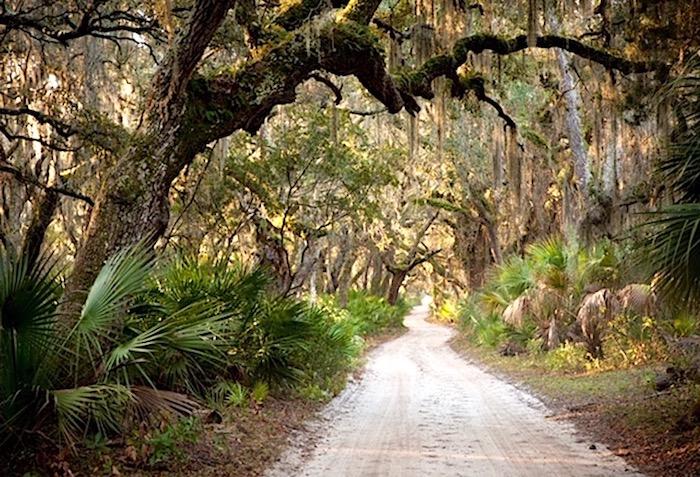
Feral horses at Cumberland Island are legendary, but where did they come from?/NPS file
Cumberland Island's Horses Out Of The Past
By Barbara "Bo" Jensen
“The boat to the island is here,” announces the ranger.
I hoist my backpack onto my shoulders and board the National Park Service ferry with less than a dozen other people. I’ve never been to Cumberland Island National Seashore, Georgia’s largest barrier island in the Atlantic. It’s cold here in winter. I’m bundled up in a down coat and wool hat. I made a camping reservation online: three nights on the island starting tonight, Monday. Three nights because the ferry doesn’t run on Tuesday and Wednesday. No going back until Thursday. I keep my hands in my warm pockets and look out the boat’s bank of windows, watching the mainland recede.
Forty-five minutes later, the ferry approaches Cumberland Island, its forested interior surrounded by saltwater marshes, shrub-covered dunes, and sandy beaches. One of the island’s famed feral horses stands on the beach at the end of the dock. It’s nibbling at a pile of Spanish moss like hay, tossing its head to shake the moss loose.
It’s also blocking the exit from the ferry – almost intentionally, it seems, as it looks over at the boat, stamps its hoof, and then goes back to eating. The other passengers and I stand to get a better look through the windows. But no one takes a step out the door. Finally, I look around at all of us huddled in the cabin, then over at the boatmen who’ve brought us here.
“We good to go?” I ask.
“Yeah! Oh, yeah,” a couple of them answer.
We laugh, maybe a little nervously, then walk resolutely down the gangplank toward shore. The horse reluctantly saunters off into the trees.
Camping Amid The Live Oaks
The wind off the bay is blowing a gale as I holler to check in at the ranger station and get shouted directions to my campsite. Hunched beneath my pack, I enter a path into the trees – and all is suddenly still. I marvel at the thick forest surrounding me, blocking the wind. Huge live oaks stand firm in the dark soil; yet, for all their solidity, they look like they’re constantly blowing in the breeze, their branches intricately twisted and shaped by the island winds. This wavy, rippling canopy is hung with the horse’s moss, and thick vines. Below, saw palmettos as tall as me fill the understory.

Camp, complete with a windbreak of live oaks/Barbara Jensen
My campsite, Sea Beach #16, is a clearing within this thicket. My footsteps are silent as I enter, softened by the rich accumulation of decaying leaves, twigs, and moss underfoot. The oaks towering overhead diffuse the light, deepening and intensifying color. I scan the site: fire ring, picnic table, metal pole with hang pegs, and a big bear box to fend off the island’s marauding raccoons. No tying my food up high between trees, no sitting on a rock or log to eat: this is luxury camping by my usual standards. There’s even a showerhouse with toilets and sinks. All the comforts of home.
In fact, Cumberland Island has been home to human beings for centuries. While the first indigenous inhabitants, the Timucuans, have left virtually no trace, Europeans and later Americans took up residence in a big way – a plantation-estate-complete-with-mansion kind of way. After setting up my tent, I grab my small daypack and set off to find the estate ruins.
Dungeness Estate
The remnants of a greenhouse, servant’s quarters, stately gated front drive with huge urns – it’s all here. I read the interpretive signs. First built as a hunting lodge in 1736, the expanded manor house was abandoned during the Civil War, and subsequently burned. Directly atop that history, another mansion was built on the same site by a different wealthy family -- Thomas Carnegie -- in 1884. It, too, burned. Now I’m surrounded by everything they left behind, solid stone walls and foundations, collapsed over time…and their domesticated animals, now gone feral.
The horses, hogs, and turkeys found on the island are not native. Instead, they are descendants of livestock brought here, not only by these families, but also by Spanish explorers occupying the island before them. Born into captivity, these animals’ ancestors somehow escaped, got lost, or were simply abandoned to fend for themselves.
It seems like it works for the turkeys. The hogs, too, are survivors; they’re so plentiful and an invasive nuisance that the Park Service schedules regular hunts during the winter.
But the horses look rough. They’re small, just ponies really, with dull, scruffy coats and wispy manes and tails. They seem awfully thin, no doubt malnourished with only moss and dune grasses to eat. According to a Park Service pamphlet, this band of horses is the only one – among several herds of Atlantic island horses – that is not managed or protected. The National Park Service makes an annual count of the animals, but that’s it. No additional feeding, no mineral blocks set out, no veterinary care. Because they’re feral, not wild. The horses don’t belong here, so they’re on their own.

Winter is a peaceful and quiet time at Cumberland Island National Seashore/Barbara Jensen
Yet people love them, anyway. They come to Cumberland Island just to see them. Like I did. I still carry a romanticized image in my mind from childhood books like Misty of Chincoteague of island horses running free, their hooves pounding along the beach. The reality before me is of tired ponies nibbling any little scrap of grass they can find.
Wary Horses Meet Wary Visitor
And then, a different horse altogether comes into view. It is stunning, white and shining, taller, stronger, and more confident; it is clearly the leader. The herd soon falls into an irregular line, heads bobbing and tails swishing gently, following the white horse back into the trees.
I have been trying to take photos of them with my phone, but it cannot capture them, their essence as shadowy outsiders, fading into the half-light of the forest and the ending of the day. I need to get back to camp before dark, since I hardly know the way. The horses have taken the shortcut path, so I walk the longer dirt road up the middle of the island, thinking. About how none of us live here now. We are all interlopers, like the horses. Twilight descends over the island as I reach camp.
The next morning, I wake early while the sky is still gray and follow a boardwalk leading to the ocean side of the island, my steps rising and falling over the dunes out to the beach. The waves are rolling more gently than yesterday. Gulls and terns wait on the wet sand at the edge of the surf, not even hunting for mussels, just standing in a huddle, looking out to sea. I approach gradually so as not to startle them, joining them at a distance. Together, we watch the sun come up behind blue morning clouds, coloring the clouds a rich purple even as they begin to thin and separate. With sunrise as their cue, the seagulls lift off noisily, beginning their day.
I start down the Parallel Trail. It runs up the center of the long, narrow island, between the access road and the ocean shore. Because it would take me two days to hike its full length, I’m taking a ranger’s suggestion and walking inland to the next campground, then returning along the beach.
I’m from the desert Southwest, so this dense, wet forest is a new world for me. I stop often to gaze at ferns growing from knots in the trees. Moss and lichen carpet the branches, the trunks. Everything is so green. Vines as thick as my forearms drape from the highest branches of the live oaks. One vine hangs invitingly, making a natural seat. I ease my weight onto it and am delighted when it supports me, swinging back and forth, grinning at my jungle game.

The horses have the run of the island, even around the Dungeness estate/NPS file
Soon, I reach the next campground, and with it, Stafford Beach, the cries of gulls, and sunshine. I hike down the island’s coast, beachcombing as I go, collecting shells. They tinkle together in my pockets like bells.
Turning in from the beach at the trail marker, I spy hoofprints in the sand. Imagining ponies running on the beach, I crane my neck and look all around, but disappointingly, they are nowhere in sight. Instead, their trail leads into the dunes beyond the boardwalks, off-limits to people.
I cross the island to tramp along a low headland over the more sheltered bay, hiking through the edge of the forest, catching occasional glimpses of the sparkling water. And suddenly, without a sound, the horses arrive.
I want to get closer to them, to try again for a decent picture. But horses are skittish creatures even when they’re tamed. To be feral seems to mean carrying a deep wariness born of broken trust. The pamphlet warns tourists not to approach them: if they change their behavior due to your presence, you’re too close. People ignoring this advice have been knocked down, kicked, bitten. They may be small, but they’re still bigger than me. I realize I am intimidated by the island ponies because I cannot predict them. I don’t trust them. I, too, am wary – of the very horses I want so badly to be near.
I move from tree to tree toward a grassy clearing, getting closer. But they easily see my orange jacket, and lift their heads to look at me. One steps forward, realigning its stance to face me directly. I chicken out and retreat toward the bluff’s edge.
As I do, the white horse floats out of the trees. It gracefully leads the other horses across the clearing – and right toward my path. If they take my trail like they did before, I will have to travel far out of my way, returning to camp long after dark.
I jog directly toward the trail. The white horse stops grazing its way toward me, but keeps its head low. Barely glancing at me, it subtly shifts its course to avoid meeting. I reach the path first and make myself walk calmly. I hear them in the underbrush beside me, twigs snapping loudly and palmettos rustling from their movement. But they keep their distance.
As I sit down to a bowl of soup at my picnic table, the sun has just set. I look up at the stars sparkling through the web of interlaced tree branches overhead. So close and yet so far, I think, wondering how to approach the horses.

Cumberland Island, as bucolic as it is, a reminder of the past, is at threat from a proposed spaceport. The Federal Aviation Administration on December 15, 2021, is supposed to announce its decision on whether to permit the spaceport in Camden (Ga.) County just a few miles west of the national seashore. The National Parks Conservation Association has strong concerns about the application. Those concerns are related to visitor and staff safety, visitor access and experience, the risk of wildfire, protection of the wilderness, wildlife, and natural, cultural and historic resources on Cumberland Island. "We are concerned for water quality in Cumberland Island marshes and on the island, the St. Marys and Satilla River and ground water, rookeries and other bird habitat, impacts on migratory birds that depend on Cumberland for a place to feed and rest on their journey, the nesting of sea turtles and impacts from light pollution, and the failure, thus far, of Camden County and FAA to address these concerns in a meaningful manner," says NPCA's Emily Jones.
Safe Adjacency
After breakfast the next morning, I head back to the beach. I hike beside the ocean for a mile or two; then, on a whim, I turn inland toward the salt marshes. I like this trail, watching the tall, graceful reeds swaying, life that has adapted to flourish in this briny wetland.
I take a leisurely stroll along this boardwalk, quietly passing low trees and overgrown leafy bushes rising like a hedge to my right. Sparrows have been flitting across my path, but other than that, this stretch of the island’s interior is nearly silent. The air is still.
All of a sudden, I hear a sound, like a sigh. I stop and look behind me, but no one is there. Yet, in this tranquil space, I hear it again. And then the unmistakable sound of a horse nearby, so close it feels like it’s right beside me. A contented horse, making a soft, deep rumbling noise in the back of its throat like the purring of a cat. I look more closely into the thicket beside me.
Squinting through the dense mesh of twigs and stems, I see a horse’s brown back, directly on the other side. I can hear its teeth rhythmically cropping the grass growing beneath the bushes, the wiry hairs of its tail whisking against its flanks with a sound like the distant waves hissing across the beach. Several horses, in fact, are wandering slowly under the cover of this hidden garden, grazing peacefully.
I step soundlessly along my side of the hedge, keeping pace with the brown horse on the other side. I can smell its warm skin, see it flick its ears, watch it rustle its mane across its neck to scratch an itch. This adjacency feels safe, for the horses as well as for me. Outsiders together, we simply accept each other’s presence and share my last afternoon on the island in companionable silence, until, one by one, they slowly drift away into the dunes of Cumberland Island.
For background on the proposed spaceport:
Rockets Over Cumberland Island National Seashore Raise Concerns
Barbara “Bo” Jensen is a writer and artist who likes to go off-grid, whether it's backpacking through national parks, trekking up the Continental Divide Trail, or following the Camino Norte across Spain. For over 20 years, social work has paid the bills, allowing them to meet and talk with people living homeless in the streets of America. You can find more of Bo's work on Out There podcast, Wanderlust, Journey, and www.wanderinglightning.com

Add comment